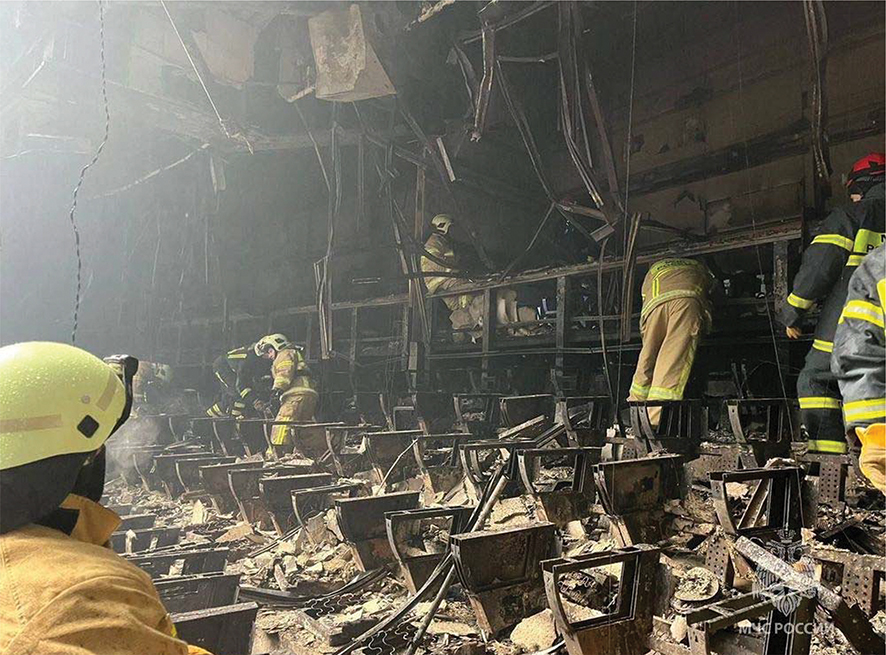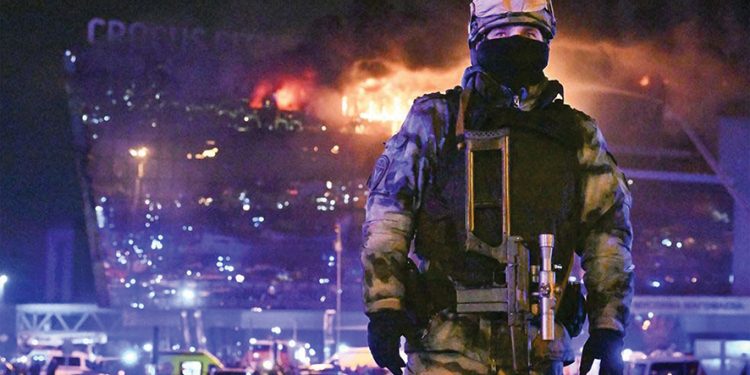On March 22, at approximately 19:55 Moscow time, a group of at least 4 assailants approached the Crocus City Hall entertainment complex, located in Krasnogorsk, a western suburb of Moscow.
Reportedly wearing a mixture of civilian clothes and some military attire, they were armed with military rifles, including an AK-12 service rifle. Walking in the east entrance, the Tajik attackers take a deep breath and let loose the first shots of what will be one of the worst terrorist attacks in Russian history.
Their first volley resulted in at least nine visually confirmed casualties. After gaining their initial foothold unopposed, the group turns south, maneuvering towards the main entrance. Pushing past security checkpoints and metal detectors, at least ten civilians are killed by point-blank gunfire. Interestingly, the teams seem to move systematically, as if the lack of opposition and the routine work of civilian executions were part of their expected work. Pushing towards the music hall, more casualties are brought down as crowds make their escape, and evacuation orders are in full swing.
Despite this, the attackers continue their offensive. At approximately 20:05, they breach into the music event hall. With cold demeanor and gloved palms on their rifles, they continue to exact their toll. Of note, one of the assailants, unarmed and with only a backpack, is seen attempting to set fire to the building. The others, with shoulder-fired rifles, continue their horrific work on the innocent civilians attempting to vacate the premises.
At roughly 20:13, the assailants begin to exit, pulling off their objective and leaving the fires to grow. With the blaze soon raging, rescue attempts are hindered and law enforcement are unable to ascertain the whereabouts of the suspects. Additionally, civilians trapped in the building are subjected to smoke and debris, causing more casualties. Much of the attack is recorded on cell phone, security camera, and social media recordings.
The attack lasted less than 20 minutes, but has at the time of printing caused 133 confirmed fatalities and over 120 injuries, some of which continue to be critical in nature. Russian police, firefighters, medical personnel, and other security forces rushed to the scene, however, several of the assailants made their escape. Heading southwest in a white Renault sedan, the four confirmed suspects were intercepted by Russian security forces, surrendering after a tense standoff. All four now await trial.
Shortly after the incident, the Islamic State in the Khorasan Province, a regional branch of the Islamic State terrorist group active in Central Asia, issued a statement claiming responsibility. They claim via their own internal information body that “The Islamic State dealt a strong blow to Russia with a bloody attack, the most violent targeting it in years. Security sources told Amaq Agency [ISIS internal news branch] that a coordinated attack was launched by Islamic State fighters, on Friday, on a large crowd of Christians in the city of Krasnogorsk on the outskirts of the capital, Moscow.”
While the attack represents a harrowing and sobering reminder that non-state actors continue to influence the security landscape in the Russo-European landscape, several key points set this incident up to be more than just a brutal, senseless attack.

During the attack, and recorded on much of the video that displays the attackers, there appears to remain an interesting dynamic. While three of the four-man group are armed and equipped with rifles, at least one remains behind the group, issuing new magazines and kit to assailants as they ply their bloody trade. Additionally, this individual seems to be equipped with demolitions and incendiary kits, resulting in the inferno that later caused more casualties and much of the structural damage.
The security at the location, according to reports and observations, prior to the attack was minimal, with only private security officers on duty. This is notable, as the United States “shared this information with Russian authorities in accordance with its longstanding ‘duty to warn’ policy,” US National Security Council spokesperson Adrienne Watson said. Following this warning, Russian President Vladimir Putin called the intelligence data “provocative” and said that “these actions resemble outright blackmail and the intention to intimidate and destabilize our society.”
Alexander Bortnikov, Director of the Federal Security Service of Russia, claimed that the US, UK, and Ukraine were “behind the attack”. Much of the Russian government has mirrored these statements, however, state-media did report that there had been a string of ISIS-related incidents. Russian security forces were reported to have engaged and eliminated cells that had been planning similar attacks in both the Kaluga region southwest of Moscow, as well as in the Ingushetia in the North Caucasus.
With Washington stressing they had no information to doubt the claims of ISIS, all available intelligence on the preparation and execution of the attack points to the terror group as the perpetrators. This invites the question – what can security, intelligence, and defense leaders do to prevent similar events?
While establishing static security posts and employing security officers are a cost consuming endeavor and often unwelcome by many event staff, they provide an initial and imperative deterrent to most overt assailants. These privately employed security personnel also require upgraded and enhanced training, beyond that which is commonly seen as adequate. Deterrence is the best first line.
With target intelligence data flowing from various sources, they absolutely must be assessed and categorized regardless of the source of the information. In this situation, the timeless adage of “the enemy of my enemy is my friend” could have saved lives, and enhanced the response of law enforcement. An unbiased filtration of incoming intelligence is key to correctly categorizing threats.
With hindsight, it’s difficult to firmly state if these would have stopped or curtailed the gunmen in Moscow outright beforehand. However, there is no doubt that it would have created a more positive security situation and facilitated the elimination of the threat either during or shortly after the event. For professional defense, security, and law enforcement officials, this acts as a sad reminder of the importance of readiness, the fight against complacency, and positioning of resources in an age that faces threats from multiple sources.
Defense Sector Review is an analysis of the regional and relevant security and defense issues by the team at Mercury Strategic Services, a defense consulting, training, and advisory company based in Tbilisi, Georgia and at www.mercstrat.com.














